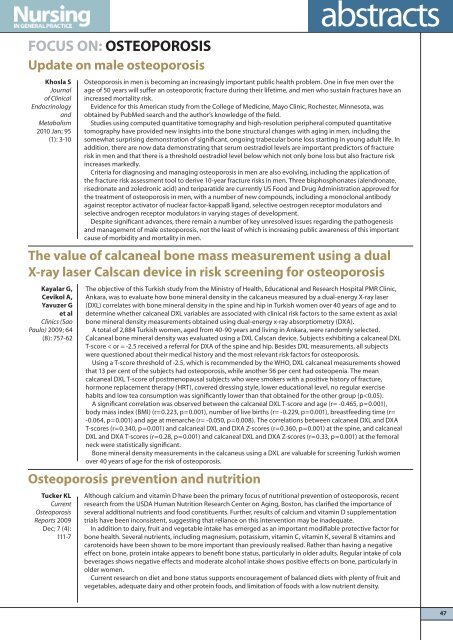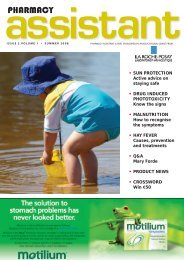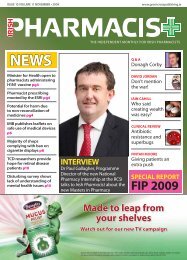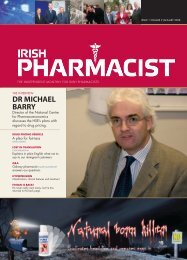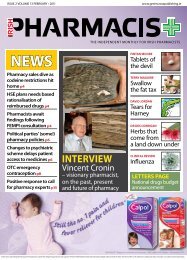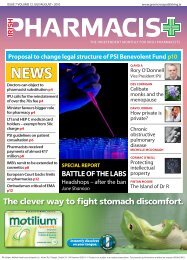veNTIlATIoN - Green Cross Publishing
veNTIlATIoN - Green Cross Publishing
veNTIlATIoN - Green Cross Publishing
You also want an ePaper? Increase the reach of your titles
YUMPU automatically turns print PDFs into web optimized ePapers that Google loves.
fOCUs On: OsTeOpOrOsis<br />
Update on male osteoporosis<br />
Khosla s<br />
Journal<br />
of Clinical<br />
Endocrinology<br />
and<br />
Metabolism<br />
2010 Jan; 95<br />
(1): 3-10<br />
abstracts<br />
Osteoporosis in men is becoming an increasingly important public health problem. One in five men over the<br />
age of 50 years will suffer an osteoporotic fracture during their lifetime, and men who sustain fractures have an<br />
increased mortality risk.<br />
Evidence for this American study from the College of Medicine, Mayo Clinic, Rochester, Minnesota, was<br />
obtained by PubMed search and the author’s knowledge of the field.<br />
Studies using computed quantitative tomography and high-resolution peripheral computed quantitative<br />
tomography have provided new insights into the bone structural changes with aging in men, including the<br />
somewhat surprising demonstration of significant, ongoing trabecular bone loss starting in young adult life. In<br />
addition, there are now data demonstrating that serum oestradiol levels are important predictors of fracture<br />
risk in men and that there is a threshold oestradiol level below which not only bone loss but also fracture risk<br />
increases markedly.<br />
Criteria for diagnosing and managing osteoporosis in men are also evolving, including the application of<br />
the fracture risk assessment tool to derive 10-year fracture risks in men. Three bisphosphonates (alendronate,<br />
risedronate and zoledronic acid) and teriparatide are currently US Food and Drug Administration approved for<br />
the treatment of osteoporosis in men, with a number of new compounds, including a monoclonal antibody<br />
against receptor activator of nuclear factor-kappaB ligand, selective oestrogen receptor modulators and<br />
selective androgen receptor modulators in varying stages of development.<br />
Despite significant advances, there remain a number of key unresolved issues regarding the pathogenesis<br />
and management of male osteoporosis, not the least of which is increasing public awareness of this important<br />
cause of morbidity and mortality in men.<br />
The value of calcaneal bone mass measurement using a dual<br />
X-ray laser Calscan device in risk screening for osteoporosis<br />
Kayalar g,<br />
cevikol A,<br />
yavuzer g<br />
et al<br />
Clinics (Sao<br />
Paulo) 2009; 64<br />
(8): 757-62<br />
The objective of this Turkish study from the Ministry of Health, Educational and Research Hospital PMR Clinic,<br />
Ankara, was to evaluate how bone mineral density in the calcaneus measured by a dual-energy x-ray laser<br />
(DxL) correlates with bone mineral density in the spine and hip in Turkish women over 40 years of age and to<br />
determine whether calcaneal DxL variables are associated with clinical risk factors to the same extent as axial<br />
bone mineral density measurements obtained using dual-energy x-ray absorptiometry (DxA).<br />
A total of 2,884 Turkish women, aged from 40-90 years and living in Ankara, were randomly selected.<br />
Calcaneal bone mineral density was evaluated using a DxL Calscan device. Subjects exhibiting a calcaneal DxL<br />
T-score < or = -2.5 received a referral for DxA of the spine and hip. Besides DxL measurements, all subjects<br />
were questioned about their medical history and the most relevant risk factors for osteoporosis.<br />
Using a T-score threshold of -2.5, which is recommended by the WHO, DxL calcaneal measurements showed<br />
that 13 per cent of the subjects had osteoporosis, while another 56 per cent had osteopenia. The mean<br />
calcaneal DxL T-score of postmenopausal subjects who were smokers with a positive history of fracture,<br />
hormone replacement therapy (HRT), covered dressing style, lower educational level, no regular exercise<br />
habits and low tea consumption was significantly lower than that obtained for the other group (p


